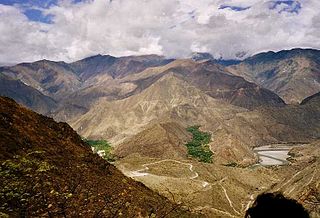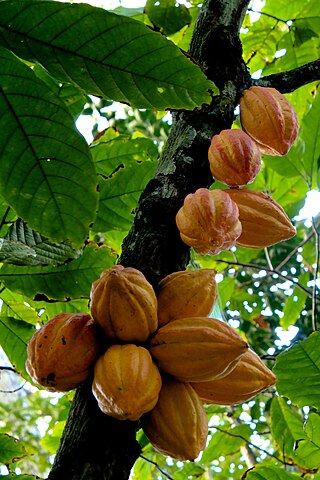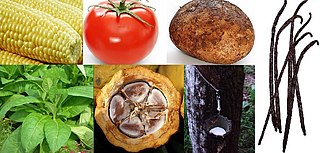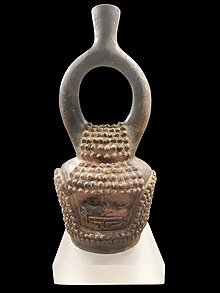
Ecuador, officially the Republic of Ecuador, is a country in northwestern South America, bordered by Colombia on the north, Peru on the east and south, and the Pacific Ocean on the west. Ecuador also includes the Galápagos Islands in the Pacific, about 1,000 kilometers (621 mi) west of the mainland. The country's capital is Quito, but its largest city is Guayaquil.

The Marañón River is the principal or mainstem source of the Amazon River, arising about 160 km to the northeast of Lima, Peru, and flowing northwest across plateaus 3,650 m high, it runs through a deeply eroded Andean valley, along the eastern base of the Cordillera of the Andes, as far as 5° 36′ southern latitude; from where it makes a great bend to the northeast, and cuts through the jungle Ande in its midcourse, until at the Pongo de Manseriche it flows into the flat Amazon basin. Although historically, the term "Marañón River" often was applied to the river all the way to the Atlantic Ocean, nowadays the Marañón River is generally thought to end at the confluence with the Ucayali River, after which most cartographers label the ensuing waterway the Amazon River.

The cocoa bean or simply cocoa, also called cacao, is the dried and fully fermented seed of Theobroma cacao, the cacao tree, from which cocoa solids and cocoa butter can be extracted. Cocoa trees are native to the Amazon rainforest. They are the basis of chocolate and Mesoamerican foods including tejate, an indigenous Mexican drink.

Theobroma cacao is a small evergreen tree in the family Malvaceae. Its seeds, cocoa beans, are used to make chocolate liquor, cocoa solids, cocoa butter and chocolate. Native to the tropics of the Americas, the largest producer of cocoa beans in 2018 was Ivory Coast, at 2.2 million tons. Its leaves are alternate, entire, unlobed, 10–50 cm (4–20 in) long and 5–10 cm (2–4 in) broad.

Amazonas is a department and region in northern Peru bordered by Ecuador on the north and west, Cajamarca on the west, La Libertad on the south, and Loreto and San Martín on the east. Its capital is the city of Chachapoyas.

Zamora Chinchipe, Province of Zamora Chinchipe is a province of the Republic of Ecuador, located at the southeastern end of the Amazon Basin, which shares borders with the Ecuadorian provinces of Azuay and Morona Santiago to the north, Loja and Azuay to the west, and with Peru to the east and south. The province comprises an area of approximately 10,559 km² and is covered with a uniquely mountainous topography which markedly distinguishes it from the surrounding Amazonian provinces. Zamora-Chinchipe is characterized and largely identified by its mining industry; indigenous ethnic groups with a rich archaeological legacy; its biodiversity; and its niche and tourist attractions, which include a number of waterfalls well-noted for their beauty. The province takes its name from the bureaucratic fusion of the Zamora and Chinchipe cantons. The provincial capital is the city of Zamora.
Jaén, founded as San Leandro de Jaén and then known as Jerez de la Frontera and finally as Jaén de Bracamoros since April 1549, is a city which is the capital of the Jaén Province in the Cajamarca Region in Peru, located in the high jungle of northern Peru. It is the seat of the Catholic Apostolic Vicariate of St. Francis Xavier, also known as Apostolic Vicariate of Jaén en Peru.
El Porvenir or Porvenir may refer to:

The Ecuadorian–Peruvian territorial dispute was a territorial dispute between Ecuador and Peru, which, until 1928, also included Colombia. The dispute had its origins on each country's interpretation of what Real Cedulas Spain used to precisely define its colonial territories in the Americas. After independence, all of Spain's colonial territories signed and agreed to proclaim their limits in the basis of the principle of uti possidetis juris, which regarded the Spanish borders of 1810 as the borders of the new republics. However, conflicting claims and disagreements between the newly formed countries eventually escalated to the point of armed conflicts on several occasions.

New World crops are those crops, food and otherwise, that are native to the New World and were not found in the Old World before 1492 AD. Many of these crops are now grown around the world and have often become an integral part of the cuisine of various cultures in the Old World. Notable among them are the "Three Sisters": maize, winter squash, and climbing beans.
The Chinchipe River is a river on the border between Ecuador and Peru. It rises in Ecuador, in the Zamora-Chinchipe Province, in the Podocarpus National Park. Then it flows through the Piura Region, and the Cajamarca Region in the San Ignacio Province of Peru. The river flows into the Maranon River.

Borja is a settlement in the Datem del Marañón Province of the Loreto Region of Peru. The hamlet is located on the banks of the Marañón River at an elevation of 165 m (541 ft). In 2017 the population was 329. Established in 1619, Borja was one of the first settlements of Spanish colonists in the Amazon lowlands of Peru. Borja became a Roman Catholic mission of the Jesuit Order in 1638. Because of European diseases and enslavement of the indigenous Maina and other ethnic groups, the population of Borja and its vicinity declined from about 3,000 in 1638 to a few hundred by the late 18th century.

The history of chocolate dates back over 5,000 years. The cacao tree is native to the tropics of the Americas. The cocoa bean was first domesticated at least 5,300 years ago in what is present-day southeast Ecuador by the Mayo-Chinchipe culture, before being introduced in Mesoamerica. Originally prepared as a drink, chocolate was served as a bitter liquid, mixed with spices or corn puree. In Mesoamerica, it was believed to be an aphrodisiac and to give the drinker strength. Today, such drinks are also known as "Chilate" and are made by locals in the south of Mexico and the north triangle of Central America. After its arrival to Europe in the sixteenth century, sugar was added to it and it became popular throughout society, first among the ruling classes and then among the common people. In the 20th century, chocolate was considered essential in the rations of United States soldiers during war.

Pre-Columbian Ecuador included numerous indigenous cultures, who thrived for thousands of years before the ascent of the Incan Empire. Las Vegas culture of coastal Ecuador, flourishing between 8000 and 4600 BC, is one of the oldest cultures in the Americas. The subsequent Valdivia culture in the Pacific coast region is another well-known early Ecuadorian culture. Ancient Valdivian artifacts from as early as 3500 BC have been found along the coast north of the Guayas Province in the modern city of Santa Elena.

Palanda Canton is a canton of Ecuador, located in the Zamora-Chinchipe Province. Its capital is the town of Palanda. Its population at the 2001 census was 7,066.

Theobroma bicolor, known commonly as the mocambo tree, jaguar tree, balamte, or pataxte, among various other common names, is a tree in the genus Theobroma, which also contains the better-known Theobroma cacao. It is found in Central and South America, including stretches of the Amazon rainforest in Brazil, Colombia, Ecuador, and Peru.

The Mayo-Chinchipe culture existed from c. 5500 – 1700 BCE in the highlands of what is now Ecuador.

Montegrande is an archaeological site in the Cajamarca department of Jaén province in Jaén District, Peru, a spiral temple or enclosure built c. 3000 BCE, by a culture that overlapped the current border with Ecuador. At 5000 years old, the site is as old as Caral. The site is located at the outskirts of the town of Jaén, Peru.

Bracamoros is a region of numerous extinct tribal groups from the Ecuadorian and Peruvian Amazon rainforest, located in the watershed of the Zamora River.
















